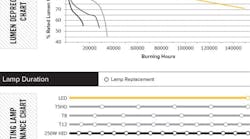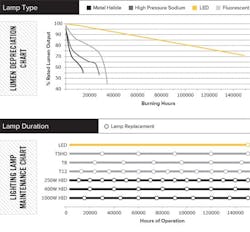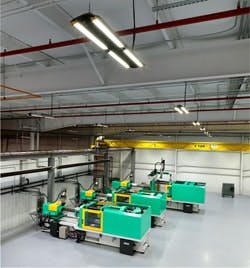5 factors to consider in your next lighting purchase
[javascriptSnippet]
The two primary concerns of facility managers considering lighting upgrades typically are energy efficiency and upfront cost. Too often, those are the only concerns. Even with a short list of options, settling on a type of lighting and supplier can be a mind-numbing and time-consuming experience.
However, with three classes of high-bay lighting now widely available – light-emitting diodes (LEDs), fluorescent tubes and high-intensity discharge (HID) lamps – it’s more likely than ever that managers will find a lighting solution that fits their budget, their energy strategy, and their workers’ needs.
To find the perfect solution, managers need to consider more than simply efficiency and upfront costs. For example, purchasing the least-expensive lighting option might not pay off if the light isn’t bright enough, causing productivity to suffer. Productivity losses can be hard to calculate, but they can easily rival the cost saved by buying cheaper fixtures. Purchasing decision-making should go beyond number-crunching to include discussions with plant floor managers and employees who will live and work under the new lights for years to come.
Grasping the true cost-effectiveness of each lighting solution requires awareness of maintenance costs, available rebates, heat load, lumen output, and more. Many consider these factors secondary to the cost-versus-efficiency debate, but they affect the overall cost-effectiveness of the upgrade and should be major considerations in purchasing decisions for industrial facilities.
1. MAINTENANCE
For many industrial facilities, maintenance is a chief deciding factor on what type of lighting to install. The longer the bulbs and ballasts last in any fixture, the less manpower and equipment is required to keep them running properly. In large facilities, even more weight should be given to maintenance costs – maintaining adequate lighting levels in facilities with more than 200 fluorescent or metal halide fixtures can easily become a nearly full-time job for maintenance crews.
Swapping bulbs in fixtures over high-production lines can also cause work stoppages for which costs are hard to calculate; however, leaving burned-out bulbs in place until the end of a shift can cause a dip in output or faulty workmanship because of poor visibility.
Companies concerned primarily with maintenance reduction should consider choosing LED fixtures, which have the highest upfront cost but which require the least maintenance of the three common types of lighting. LEDs don’t use bulbs and have a typical rated life of 100,000 to 150,000 hours. By comparison, metal halide bulbs last only about 15,000 hours, and fluorescent tubes last about 35,000 hours on average.
Any industrial lighting proposal should include a maintenance savings estimate as well as energy savings. For example, a lumber company that recently replaced 204 metal halide fixtures in its distribution center with high-bay LEDs is expected to save nearly $21,000 per year. About $13,000 of the expected savings are from reduced energy use – the other $8,000 reflects a cost calculation for reduced maintenance
2. HEAT LOAD
Everything that uses electricity creates heat, and lights are no exception – in fact, they can be the worst offenders in an industrial facility. HIDs, such as metal halides, generate the most heat – temperatures can rise to 350°F – which means 25 standard 400-watt metal halide fixtures produce about the same amount of heat as a 45,000 BTU gas-fired heater. By comparison, fluorescents produce about 150°F and LEDs produce about 100°F.
Internal heat load generated by lighting can be a serious concern for industrial facilities that already experience comfort issues because of a lack of air conditioning. Costly refrigerant-based cooling at a typical 100,000- or 200,000-square-foot plant or warehouse with a 40-foot ceiling is impractical, so such facilities often use fans and ventilation to keep cool in the summer. Many managers don’t realize that their lights could potentially be making the situation worse – metal halides in particular can easily raise ground-level temperature by 3°F or more.
At the other end of the spectrum, in cold climates, metal halides may contribute to worker comfort. However, that warmth can be gained more efficiently by using an effective heating system and destratifying the air – pushing down rising heat – with overhead fans in the space.
3. LENGTH OF STAY
Lighting is a long-term investment, so the length of time the purchaser plans to occupy the facility should factor into any purchasing decision. If return on investment is the primary concern for facility managers, then the amount of time the lights will continue functioning after the ROI is met is likely a close second.
Take the lumber company mentioned earlier: over the course of 10 years, LEDs will save the facility about $210,000 in energy and maintenance costs – more than twice the upfront cost of the project. However, if the building owners had planned to move within five years, the facility would meet their ROI, but wouldn’t benefit from continued energy savings.
Companies using metal halides but planning to move within the next few years, might be better served by a lighting upgrade with a lower upfront cost, such as fluorescents. Even though fluorescents on average, use about 5% to 10% more energy than LEDs and require far more maintenance, inexpensive fluorescents are still more energy-efficient than metal halides and can result in significant savings with a reasonable ROI.
4. REBATES
Energy companies want facilities to use more-efficient lights, so many are incentivizing upgrades with rebates. Energy rebates can cover from 10% to 50% of a project’s costs when switching from an older or inefficient system. In the lumber company example, rebates were expected to pay about $11,500.
Rebates should be included in a lighting proposal, but it’s important to remember that rebates vary among utility companies, and they’re not always guaranteed. Because the purchasing process can be time-consuming, rebate dollars that were available at the start of a lighting project might not be available at the end.
Additionally, installation companies may try to take a cut of the rebate or charge a fee to administer it. Purchasers should search for a company that includes rebate administration with installation at no additional cost.
5. ILLUMINATION AND PRODUCTIVITY
Productivity loss is difficult to express in dollars, but it’s generally accepted that low lighting levels can result in dreary employees and faulty workmanship, which is potentially unsafe. There’s serious science behind recommended foot candles – the measure of usable light in a space. The Illuminating Engineering Society recommends 20 to 50 foot candles for most industrial applications, and 100 to 500 for sight-sensitive tasks such as sewing, scribing, and inspecting.
Facilities can most easily reach recommended foot candle levels with LEDs and metal halides. However, metal halides typically dim to half their original brightness within two years, whereas LEDs maintain about 70 percent of their brightness for up to 17 years of 24-hour use. Because metal halide lumen loss occurs steadily, it can be difficult to notice that foot candles have fallen below recommended levels. Regular testing is recommended.
Regardless of the type of fixture purchased, maintaining adequate lighting levels can contribute to increased productivity and fewer mistakes. It also reduces the human and financial costs of job-related injuries.
On cutting costs...
Lighting typically accounts for 25% to 40% of energy used in a business, according to the U.S. Environmental Protection Agency, but that number doesn’t include maintenance and production costs. To maximize savings, facilities should study all the benefits and drawbacks of each type of fixture, include all the stakeholders in the conversation, and consult with lighting companies that have well-educated sales personnel, engineers and installers on staff. A well-lit facility will pay off in ways that those driven only by cost and energy savings might miss.




